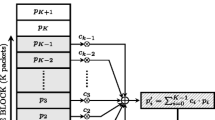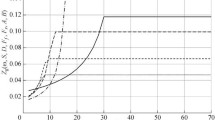Abstract
Pure end-to-end error recovery fails as a general solution to optimize throughput when wireless links form parts of the end-to-end path. It can lead to decreased end-to-end throughput, an unfair load on best-effort networks, and a waste of valuable radio resources. Link layer error recovery over wireless links is essential for reliable flows to avoid these problems. We demonstrate this through an analysis of a large set of block erasure traces measured in different real-world radio environments, with both stationary and mobile hosts. Our analysis is based on a case study of the circuit-switched data service implemented in GSM. We show that the throughput on this wireless channel can be increased by using a larger (fixed) frame size for the reliable link layer protocol. This yields an improvement of up to 25% when the channel quality is good and 18% even under poor radio conditions. Our results suggest that adaptive frame length control could further increase the channel throughput. Finally, we discuss link and transport layer error control mechanisms and their interactions with end-to-end congestion control schemes. For reliable flows, we argue in favor of highly persistent error recovery and lossless handover schemes implemented at the link layer.
Similar content being viewed by others
References
M. Allman, V. Paxson and W. Stevens, TCP congestion control, RFC 2581 (April 1999).
A. Bakre and B.R. Badrinath, I-TCP: Indirect TCP for mobile hosts, in: Proceedings of ICDCS'95 (May 1995).
H. Balakrishnan, S. Seshan and R.H. Katz, Improving reliable transport and handoff performance in cellular wireless networks, Wireless Networks 1(4) (December 1995) 469–481.
H. Balakrishnan and R.H. Katz, Explicit loss notification and wireless web performance, in: Proceedings of IEEE GLOBECOM'98 (1998).
P. Bhagwat, P. Bhattacharya, A. Krishna and S.K. Tripathi, Using channel state dependent packet scheduling to improve TCP throughput over wireless LANs, Wireless Networks 3(1) (January 1997) 91–102.
S. Blake et al., An architecture for differentiated services, RFC 2475 (December 1998).
R. Braden, Requirements for Internet hosts – Communication layers, RFC 1122 (October 1989).
B. Braden et al., Recommendations on queue management and congestion avoidance in the Internet, FC 2309 (April 1998).
K. Brown and S. Singh, M-TCP: TCP for mobile cellular networks, ACM Computer Communication Review 27(5) (October 1997).
R. Cáceres and L. Iftode, Improving the performance of reliable transport protocols in mobile computing environments, IEEE Journal on Selected Areas in Communications 13(5) (June 1995) 850–857.
S. Deering and R. Hinden, Internet Protocol, Version 6 (IPv6) specification, RFC 2460 (December 1998).
M. Degermark, B. Nordgren and S. Pink, IP header compression, RFC 2507 (February 1999).
R.C. Durst, G.J. Miller and E.J. Travis, TCP extensions for space communications, in: Proceedings of ACM MOBICOM'96 (1996).
D.A. Eckhardt and P. Steenkiste, Improving wireless LAN performance via adaptive local error control, in: Proceedings of IEEE ICNP'98 (1998).
ETSI, Radio Link Protocol for data and telematic services on the Mobile Station–Base Station System (MS–BSS) interface and the Base Station System–Mobile Switching Center (BSS–MSC) interface, GSM Specification 04.22, Version 5.0.0 (December 1995).
ETSI, Digital cellular communications system (Phase 2+), Radio Link Protocol for data and telematic services on the Mobile Station–Base Station System (MS–BSS) interface and the Base Station System–Mobile Switching Center (BSS–MSC) interface, GSM Specification 04.22, Version 6.1.0 (November 1998).
ETSI, Digital cellular communications system (Phase 2+), Rate adaption on the Mobile Station–Base Station System (MS–BSS) interface, GSM Specification 04.21, Version 7.0.0 (October 1998).
ETSI, Digital cellular communications system (Phase 2+), General Packet Radio Service (GPRS), Mobile Station (MS)–Base Station System (BSS) interface, Radio Link Control/Medium Access Control (RLC/MAC) protocol, GSM Specification 04.60, Version 6.1.0 (August 1998).
ETSI, Digital cellular communications system (GSM Radio Access Phase 3), Channel coding, GSM Specification 05.03, Version 6.0.0 (January 1998).
S. Floyd, V. Jacobson, C. Liu, S. McCanne and L. Zhang, A reliable multicast framework for light-weight sessions and application level framing, IEEE/ACM Transactions on Networking 5(6) (December 1997) 784–803.
T.R. Henderson and R.H. Katz, Transport protocols for Internet-compatible satellite networks, IEEE Journal on Selected Areas in Communications 17(2) (February 1999) 326–344.
V. Jacobson, Congestion avoidance and control, in: Proceedings of ACM SIGCOMM'88 (1988).
V. Jacobson, Compressing TCP/IP headers for low-speed serial links, RFC 1144 (February 1990).
V. Jacobson, R. Braden and D. Borman, TCP extensions for high performance, RFC 1323 (May 1992).
P. Karn and C. Partridge, Improving round-trip time estimates in reliable transport protocols, in: Proceedings of ACM SIGCOMM'87 (1987).
P. Karn, The Qualcomm CDMA digital cellular system, in: Proceedings of the USENIX Mobile and Location-Independent Computing Symposium, USENIX Association (August 1993).
S. Kent and R. Atkinson, Security architecture for the Internet protocol, RFC 2401 (November 1998).
M. Kojo, K. Raatikainen, M. Liljeberg, J. Kiiskinen and T. Alanko, An efficient transport service for slow wireless telephone links, IEEE Journal on Selected Areas in Communications 15(7) (September 1997) 1337–1348.
P. Lettieri and M.B. Srivastava, Adaptive frame length control for improving wireless link throughput, range, and energy efficiency, in: Proceedings of IEEE INFOCOM'98 (1998).
R. Ludwig and B. Rathonyi, Link layer enhancements for TCP/IP over GSM, in: Proceedings of IEEE INFOCOM'99 (1999).
R. Ludwig, B. Rathonyi, A. Konrad, K. Oden and A. Joseph, Multilayer tracing of TCP over a reliable wireless link, in: Proceedings of ACM SIGMETRICS'99 (1999).
R. Ludwig, A case for flow-adaptive wireless links, Technical report UCB//CSD-99-1053, University of California at Berkeley (May 1999).
R. Ludwig and R.H. Katz, The Eifel algorithm: Making TCP robust against spurious retransmissions, ACM Computer Communication Review 30(1) (January 2000).
R. Ludwig and K. Sklower, The Eifel retransmission timer, ACM Computer Communication Review 30(3) (July 2000).
M. Mathis, J. Mahdavi, S. Floyd and A. Romanow, TCP selective acknowledgement options, RFC 2018 (October 1996).
M. Meyer, TCP Performance over GPRS, in: Proceedings of IEEE WCNC'99 (1999).
M. Mouly and M.-B. Pautet, The GSM System for Mobile Communications (Cell&Sys, France, 1992).
B.D. Noble, M. Satyanarayanan, G.T. Nguyen and R.H. Katz, Trace-based mobile network emulation, in: Proceedings of ACM SIGCOMM'97 (1997).
PILC (Performance Implications of Link Characteristics), Working Group, Internet Engineering Task Force, Mailing list, http://pilc.grc.nasa.gov/pilc/list/archive/
J. Postel, User Datagram Protocol, RFC 768 (August 1980).
J. Postel, Internet Protocol, RFC 791 (September 1981).
J. Postel, Transmission Control Protocol, RFC 793 (September 1981).
K.K. Ramakrishnan, S. Floyd and D. Black, The addition of explicit congestion notification (ECN) to IP, RFC 3168 (September 2001).
J.H. Saltzer, D.P. Reed and D.D. Clark, End-to-end arguments in system design, ACM Transactions on Computer Systems 2(4) (November 1984).
N.K.G. Samaraweera and G. Fairhurst, Reinforcement of TCP error recovery for wireless communication, ACM Computer Communication Review 28(2) (April 1998).
W. Simpson, The Point-to-Point Protocol, RFC 1661 (July 1994).
R. Srinivasan, RPC: Remote Procedure Call protocol specification, Version 2, RFC 1831 (August 1995).
W.R. Stevens, TCP/IP Illustrated, Vol. 1, The Protocols (Addison-Wesley, 1994).
Sun Microsystems Inc., NFS: Network File System protocol specification, RFC 1094 (March 1989).
G.R. Wright and W.R. Stevens, TCP/IP Illustrated, Vol. 2, The Implementation (Addison-Wesley, 1995).
V. Paxson and M. Allman, Computing TCP's retransmission timer, RFC 2988 (November 2000).
J. Mogul and S. Deering, Path MTU discovery, RFC 1191 (November 1990).
Author information
Authors and Affiliations
Rights and permissions
About this article
Cite this article
Ludwig, R., Konrad, A., Joseph, A.D. et al. Optimizing the End-to-End Performance of Reliable Flows over Wireless Links. Wireless Networks 8, 289–299 (2002). https://doi.org/10.1023/A:1013750211660
Issue Date:
DOI: https://doi.org/10.1023/A:1013750211660




